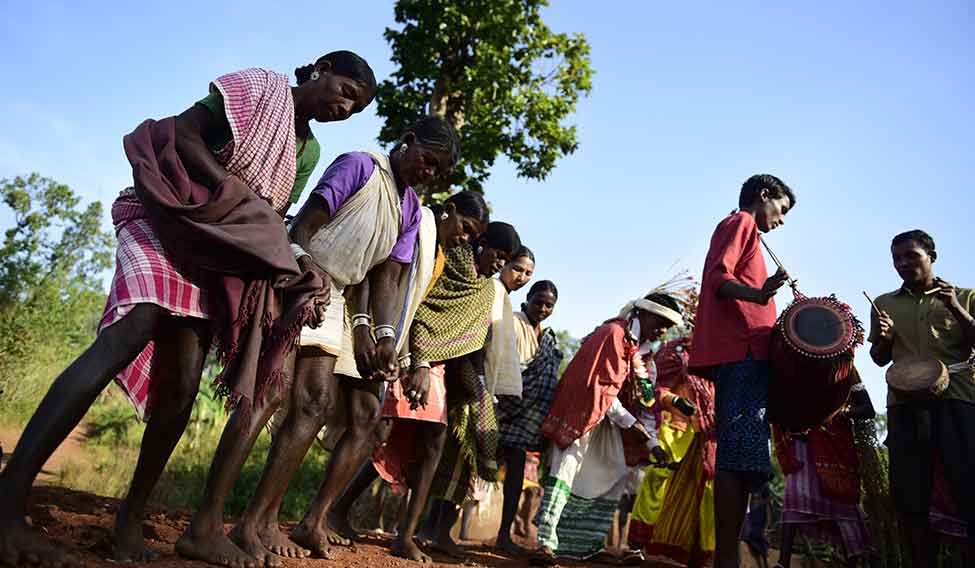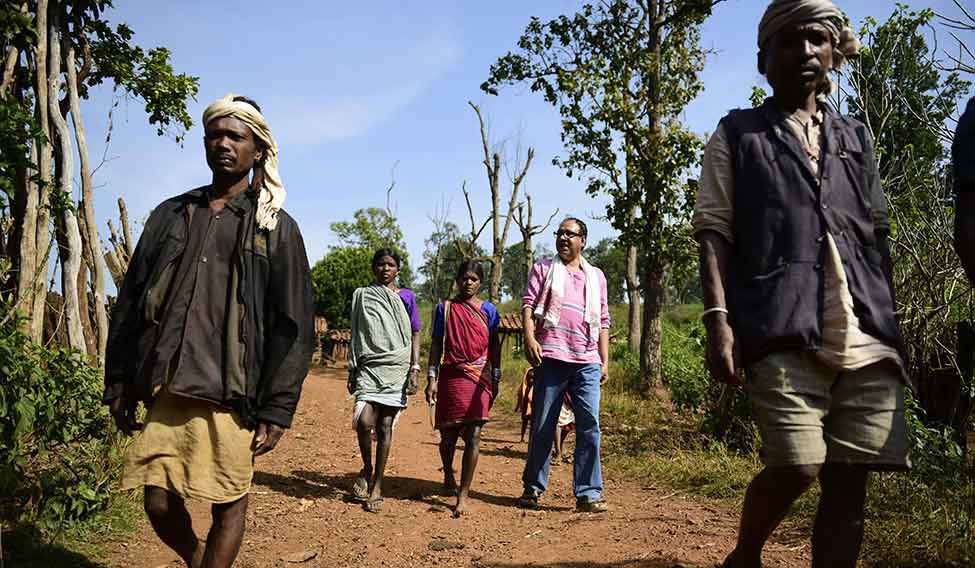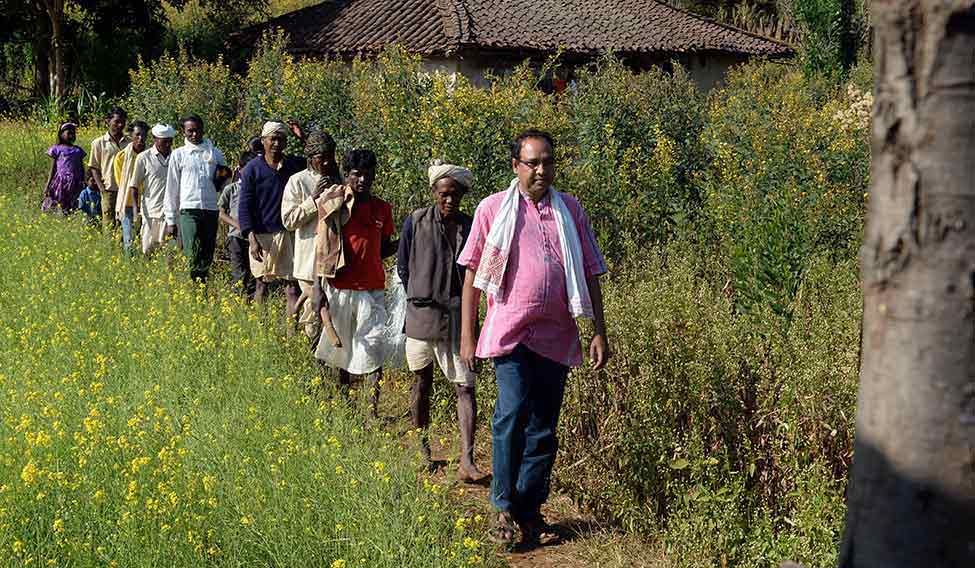Baigas... still practise their ancient method of cultivation, though many of them have been persuaded to take to plough. But no Baiga ploughs save with a wistful heart.
Bewar is their tradition; it is in their blood; it is the mark of their race; it is the sole reminder that they were once the kings of the forest.
God himself came to their great ancestors as they were eating roots in the jungle, and showed them how to do Bewar, giving them the first seeds with his own hands.
The Baigas have a passionate love for Bewar. I have no doubt that this almost religious devotion is connected with their reverence for Mother Earth.
Now because of the hunger and the strange laws of this age, they have to dishonour her, lacerating her fair breasts with the plough.
Verrier Elwin, Leaves from the Jungle (1936)
Many people called him an eccentric. They could not fathom why a missionary Englishman, son of an Anglican bishop who graduated from Oxford, would break ties with the clergy, leave behind all comforts and settle with the tribals of north India.
But, the celebrated anthropologist—or “philanthropologist”—Verrier Elwin never cared about what the 'outside world' thought about him.
“Is it eccentric to live in beautiful scenery in the hills among some of the most charming people in the country, even though they may be ignorant and poor?” he asked.
Elwin embraced the Baiga tribe of Madhya Pradesh. He spent 22 years with them, yearning to be one among them.
The Baigas once called themselves “the lords of the jungle’’. But, modernisation pushed them to the edge, with their identity down in the abyss. They became slaves of modernity.
The Baigas, however, do not complain; they rarely speak. They run and hide in the bushes at the sight of a city man.
Chief Photographer Salil Bera and I are in Talaidabra, one of the 52 impoverished villages of Dindori district in Baigachak region—a buffer zone between Kanha Tiger Reserve and Achanakmar Wildlife Sanctuary of Chhattisgarh.
Baiga villages dot these parts of the Maikal hill ranges, from where the rivers Narmada and Son originate. We are here to meet Amarsingh Rathudia, a Baiga.
We find him sitting calmly in his hut. There is a bottle of country liquor in a corner. His wife is busy preparing a meal of crabs and millets for over a dozen villagers who have gathered at his house. His two children are at the government school nearby.
There is no awkwardness among the Baigas; they are more than welcoming. That is because we have accompanied their bhaiya—Naresh Biswas—who is believed to be an avatar of Elwin.
Meet our last five Man of the Year award winners
Amarsingh is among the hundreds of Baigas who have gone back to traditional bewar or slash-and-burn (swidden) cultivation that has been part of the tribe's identity. “I am a relaxed and happy man today,” says Amarsingh.
In another distant village named Chapwar, we meet another happy Baiga, Chandrasingh Khagoria. Despite owning 15 acres, he lived in penury until a few years ago. He lost three consecutive crops of paddy because of drought.
His life, he says, changed when he attended a meet mela (friends' fair) organised by Biswas. Khagoria was motivated to revive bewar, and given a bunch of old seeds. Now, he cultivates both paddy and bewar crops, a mixed farming method for millets, oilseeds and vegetables.
The Baigas were a happy-go-lucky tribe. They never stored for tomorrow. They never knew the perils of modernity.
“Ek bita jag jita.Sanjh khay bihana rita (The stomach is just a span broad; you go through the world for it. Eat in the evening; empty it in the morning),” goes a Baiga proverb.
Elwin, too, had noted this aspect in his diary: “Some of their [Baigas] songs quite charming, and their dancing excellent, but they are not very well-informed about the facts of life. ‘Do you know anything of your past?’ we ask all agog for some fresh anthropological information. ‘We don’t know anything about the past; what we are interested in are our stomachs.’ Have you ever heard of Mahatma Gandhi? we asked. “We are not interested in mahatmas; all we care for is the stomach,’ they reply again, affectionately patting that organ.”
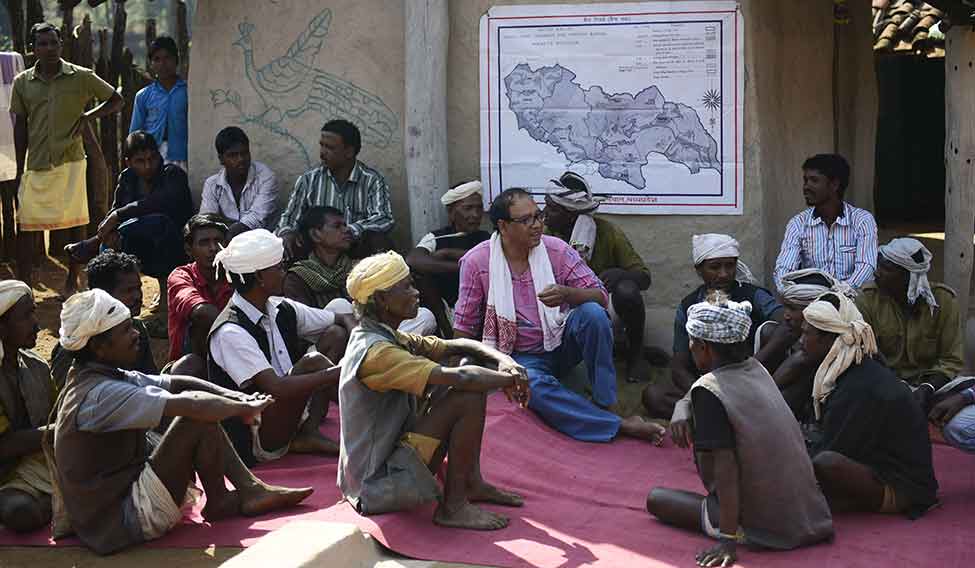 Centre of attention: Biswas has been working for the welfare of the Baiga tribe for two decades.
Centre of attention: Biswas has been working for the welfare of the Baiga tribe for two decades.
Declared as one of the 76 primitive tribes in India, there are about 3.5 lakh Baigas mainly across Dindori and Anuppur districts in Madhya Pradesh and Raigarh in Chhattisgarh.
For two decades, Biswas has been on a mission to ensure that no Baiga stomach goes empty because of ‘external interferences’.
Ever since the British commissioner of Jabalpur division demarcated the Baigachak region, the tribe has been in a spot. Baigachak was declared a Baiga reserve, and bewar was banned outside this limit.
Today, Biswas, 52, rides a motorcycle across the hilly terrains of Dindori to 'free' the Baigas. And he calls this independence movement “Bewar Swaraj”.
The term 'Bewar Swaraj' was first used in one of Elwin's works, when he quoted Ketu Baiga of Niwas village—“The English are giving swaraj to everyone but the Baiga; why can’t they give us Bewar Swaraj?”
In bewar farming, Baigas grow eight to ten varieties of millets and corn and five varieties of legumes in a single plot. Bewar, Biswas stresses, ensures freedom from hunger.
Under the traditional method of bewar, wild vegetation was felled and burnt, and every time new plots were cultivated. But, Biswas promoted the concept of a family using a single plot. And he asked the Baigas not to chop down trees, but to target lantana-infested fields instead. (See graphics on page 28)
In the process of liberating the Baigas, Biswas has had conflicts with local cloth merchants, moneylenders, forest officials, the local administration and even his wife.
He was jailed on charges of instigating adivasis to fell trees; traders threatened him for jeopardising their exploitative business; the police suspected him to be a Naxalite; and his tribal wife fought over his habit of drinking country liquor with Baigas and returning home late.
Swaraj is not easy to achieve, says Biswas. Over the years, thanks to pressure from the ‘rulers’, Baigas stopped bewar and switched to paddy cultivation.
“Government agencies believe that low use of fertilisers, modern seeds and machines indicates backwardness,” says Biswas. “So, the tribals have been forced to use new high-yielding varieties of paddy, which require chemical fertilisers and vast amounts of pesticides.”
This often led the Baigas into debt traps, especially after crop failure.
“Now, we practise both paddy and bewar cultivation,” says Lalsai Baiga. “If there is low rainfall, the paddy wilts, but bewar gives a bumper crop. In case of excess rains, the paddy gets pest-infested, but bewar survives. During the harvest season, too, the bewar crop has better chances of survival in case of rains. In paddy fields, water accumulates and the grains rot. But since the bewar plots are on hilly slopes, the rainwater drains off.”
Also, bewar is a safe bet, as the mixing of crop depends on the expected rainfall. “The Baigas have their own science of rainfall prediction, which is highly accurate,” says Biswas.
Goru Rathoriya of Ajgar village says, “Our seeds have a treasure of past experience inbuilt. They are accustomed to vagaries of nature, while the modern seeds are yet to learn the local environment.”
Goru has created a seed bank in his house, and every season he loans the seed to fellow tribals in need. “We have created a network through which farmers from Raigarh, Anuppur, Dindori and Mandla districts exchange seeds,” says Biswas.
There is a huge demand for such food in urban India, where health consciousness is growing and people eat more coarse grains. “There are times when millets are sold at higher prices than paddy,” notes Biswas.
Budh Singh of Goura village, for instance, had saved about 30 quintals of little millet seeds over four decades. Last year, he sold them for 160,000 in the open market.
Several women’s self-help groups, too, have bloomed across the region, to reap the benefits of this boom.
In 21 villages of Dindori, Anuppur and Raigarh, Biswas has persuaded more than 700 families to revive bewar. He has also documented and, to an extent, revived traditional food habits of Baigas.
Biswas identified the tubers, millets and other forest produce consumed by the older generations of Baigas. He promotes them among the youth by holding food fairs in schools. Over a dozen varieties of plants have been reintroduced through such fairs.
“I have documented 98 types of Baiga food and their nutritional values,” says Biswas. “They are made of locally available tubers and crops. The millet recipe, for instance, is so nutritious for children; we proved this at an anganwadi in Bhanpur village.”
Now, the Madhya Pradesh bio-diversity board wants Biswas to replicate his campaign outside the Baigachak region.
Appreciating his work, the South Asia Network on Food, Ecology and Culture published his book Bewar Swaraj. The international ecology network Using Diversity also supports his efforts. It keeps sending foreign groups to study and document bewar.
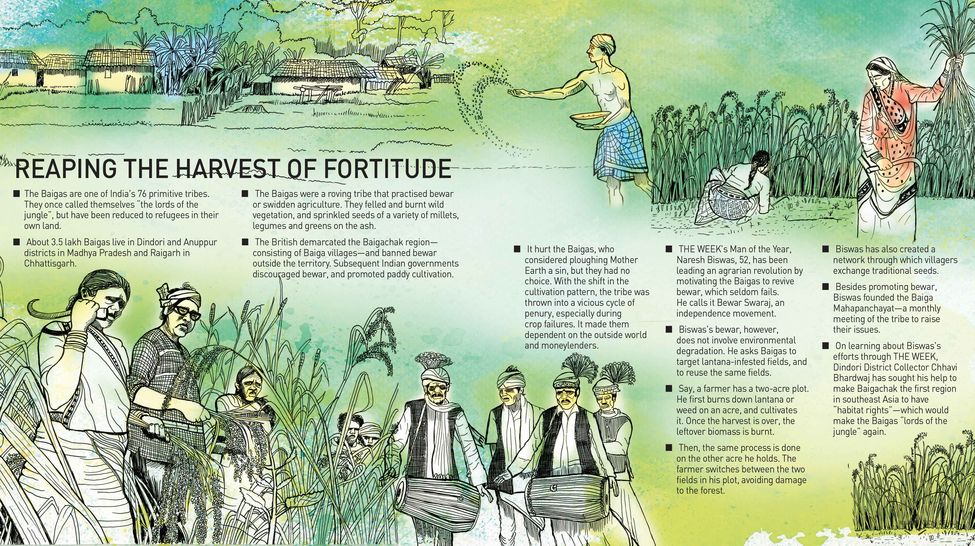 Illustration: Deni Lal
Illustration: Deni Lal
The seed man's roots
Biswas is not an academic activist; he has deep-rooted ties with agriculture. He was born in 1963 into a Bangladeshi refugee family settled in Raigarh, Chhattisgarh. In 1954, his parents had slipped into India, as communal violence snuffed out hordes of Bangla Hindus.
Like many other refugees, his father was given seven acres in Raigarh as a source of livelihood. While the Indian government opened schools and other amenities in the area, the settlers converted the barren land into agricultural fields. They produced paddy, watermelon and vegetables.
Biswas studied in a government school in Dharmjaygarh village in Raigarh and graduated from Guru Ghasidas University, Bilaspur.
While awaiting his BA degree in 1984, Biswas joined Ekta Parishad, a voluntary organisation working for land rights for the poor. And in 1996, he came to the Mandla-Dindori area as a coordinator of Ekta Parishad. That was the turning point.
He was shocked by the living conditions of Baigas. Exploitation at the hands of traders and moneylenders was blatant. Seeing this, Biswas decided to spend his life among them.
Initially, when he visited Baiga villages, most of men and women would run and hide in the maize crop. It took him months to earn their trust. As they ran, he went closer to them.
Even now, whenever he goes to Baigachak region, Biswas ensures that he eats and drinks at a Baiga’s house. Now, however, he is welcomed with karma dance—a rare honour for an outsider—every time he attends a Baiga meeting.
Biswas immersed himself in the world of tribals—pretty much like Elwin did.
There is a difference, though. While Elwin could count on associates such as Mahatma Gandhi, Jawaharlal Nehru and Jamnalal Bajaj, Biswas has ‘ordinary’ friends who give him Rs.10,000 to 15,000 every year.
These friends are mostly activists and filmmakers. One such prominent donor, not wanting to be named, is a Delhi-based filmmaker who visited the region to make a documentary on medicinal plants.
As in the case of Elwin, love struck Biswas in 1996, when he was working in the tribal village of Bhimpur in Betul, Madhya Pradesh. While Elwin had fallen in love with a Baiga, Biswas fell for a Gond girl. “Tribals are very sensitive when it comes to someone falling in love with their girl,” he says, sheepishly.
Till then, Biswas never thought of starting a family. The tribals were his family. It was “royal life”, he says. “Often, they [the tribals] used to stay overnight at my house and cook for themselves and me. They used my house as a lodge. I gave them shelter and they gave me food.”
Eventually, with the help of some friends, Biswas married his love, Munia Morskole, at the Arya Samaj temple in Indore.
Munia moved around with Biswas to support his efforts. However, with the birth of two children, she became a homemaker. And she displayed all signs of that transformation.
“She feared for my life, as she knew how dangerous Baigas or any tribal could be,” says Biswas. “Being herself an adivasi, she also feared witchcraft of Baigas.”
Witchcraft may sound like bunkum to the outside world, but, deep inside the woods, it is still feared.
Even Elwin was once left shaken: “I was standing in the forest when a large pig lumbered up to me with a leaf in its mouth which it dropped at my feet,” he writes in An Autobiography. “I was rather moved by this—sort of Francis among the birds touch, I thought— and then forgot all about it. But no sooner had I returned home than I went down with a violent attack of fever. The local magicians waited on me, and soon diagnosed the cause—the witch of Bohi, annoyed at my presence in the village, had put magic into a leaf and sent it to me by her pig. They immediately took necessary measures and I recovered.”
Munia, however, steeled up. “Life was a struggle during those days. The children were growing and daily needs increasing but, somehow, we pulled it off,” says the proud wife, who has completed graduation. Their children, Shivali, 15, and Seemanto, 7, study in Navodaya Vidyalaya in Mandla district.
The struggle
Biswas concluded that the best way to empower the community is to give them economic freedom and revive their traditions.
Once in the summer of May, Biswas stopped at the house of a Baiga, Dharamdas, in Mawai village. The intense heat had made him weary. Biswas asked Dharamdas for water and permission to rest in the house.
While lying on a cot, Biswas noticed a dilapidated wooden loom hanging over him. Dharamdas was a weaver who had shut his loom for want of yarn and capital. The same day, during a meeting in a Baiga village, Biswas was told of the high cost of mungis (Baiga saris) and the problems of boys in getting married.
Every marriage in Baiga family means debt. When a Baiga marries, he has to gift five mungis to the bride's family. Often, men are unable to buy the mungis, which cost Rs2,000 to 2,500 each. This means either they remain bachelors or are forced to take a loan from the local bania. Every loan throws the family into a vicious cycle of compound interest.
Biswas asked Dharamdas to revive his loom, and assured him the required capital and yarn. He took a loan of Rs10,000 from a friend and bought yarn from Bilaspur. The first consignment of cloth was woven as per plans, and it was sold at subsidised rates to Baiga men. They were elated.
“I bought seven saris at subsidised rates to get my wife from village Bargaon,” recalls Ganga Singh Khohadia, with a broad smile.
The weaving venture was run on a no-profit-no-loss basis. While the saris were sold at a subsidised price to Baigas, the loss was made up for by selling Baiga shirts at urban fairs.
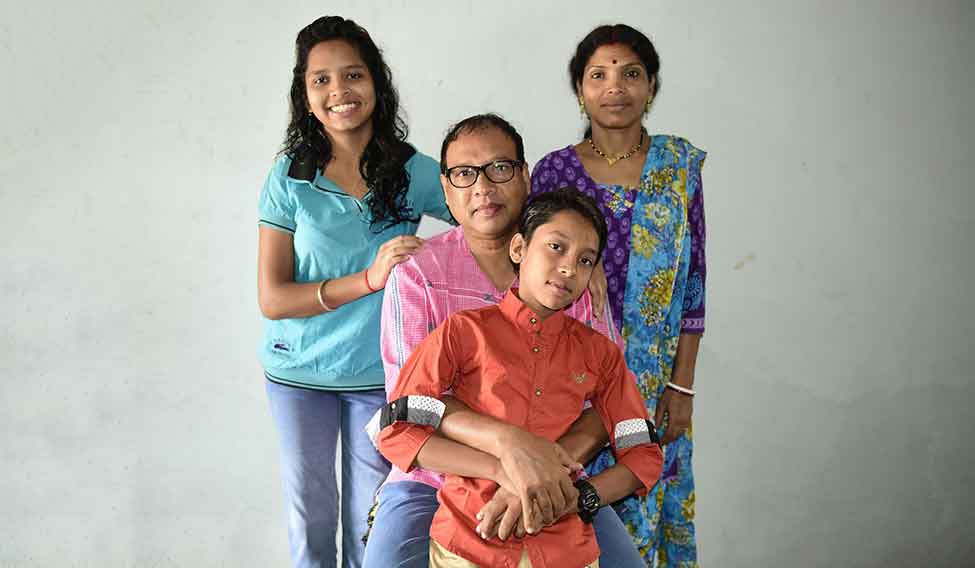 Home affairs: Biswas fell in love with Munia, a Gond tribal, in 1996. The couple has two children, Shivali and Seemanto.
Home affairs: Biswas fell in love with Munia, a Gond tribal, in 1996. The couple has two children, Shivali and Seemanto.
The cloth merchants of Bajag village were furious. Bajag is the biggest Baiga market in the region where cloth merchants double as moneylenders. They threatened Biswas. When that did not work, they blocked the supply of yarn from Bilaspur.
But a former MLA and socialist leader of Raigarh, Ramkumar Agarwal, came to the rescue. He asked his relatives in Bilaspur to supply yarn, and the venture took off again.
Even as the business was doing well, in 2007, a government scheme lured away the weavers. The weavers were asked to knit fine kosa cloth instead of cotton. The scheme collapsed within a year, and the weavers were left in the lurch.
“The purpose of providing cheap mungis was not economical, but it was more related to Baiga culture,” says Biswas. “Since mungis are sold at high prices, Baigas are gradually moving towards modern clothing. This would ultimately lead to the death of Baiga clothes.”
The Baiga life
The Mandla district gazetteer of 1912 narrates an interesting story. A Baiga who was given a bounty of Rs25 was asked how he would spend it. He replied that Rs13 would go to the moneylender, Rs2 on food and clothing, and the remaining 10 on liquor.
Moneylenders and traders have been the biggest curse in the lives of Baigas for ages. They ruthlessly exploited the ignorant tribals.
The only thing for which Baigas depend on the outside world is salt. Traders bartered salt with mustard produced by the Baigas. Every kilo of salt was exchanged with one kilo of mustard!
This blatant cheating by the banias stopped when Biswas supplied the villages with salt at the actual price. The banias bayed for his blood, but the experiment worked.
Years later, the state government launched a brand named Vanya Namak and distributed salt free of cost in adivasi villages.
Biswas also fought the evil social customs such as jat miloni (reintroduction into caste). In 2005 when a Baiga girl was raped by Yadav boys, the tribe ostracised her. Biswas got those boys punished, and made jat miloni a symbolic ritual. Earlier, the custom required a feast and the inhuman ritual of tonsuring the girl and making her bathe in public.
Another big achievement came when Biswas met the block development officer to file an RTI application. Biswas wanted to know the status of Supreme Court order of May 3, 2003, which had made all primitive tribes automatically eligible for Antyodaya cards (which entitle them to get subsidised ration at Rs.1 a kilo).
The officer showed him the file where the entire list of Baigas included in the Antyodaya was attached. In the same file, Biswas saw one of his old letters to then chief minister Uma Bharti, asking her to take note of the Supreme Court judgment. Bharti, apparently, had acted swiftly on the issue.
The birth of Baiga Mahapanchayat
On August 16, 2000, a Baiga came running to Biswas as the forest staff were destroying Baiga fields. On August 23, Biswas called a meeting, where Baigas could raise their voice against the atrocities.
However, as the police arrived on the spot, no one dared to speak up. “At this point,” Biswas recalls, “one Shikari Baiga stood up and narrated the atrocities inflicted on the tribe.’’ Hence, Biswas dedicated his book, Bewar Swaraj, to the old Baiga.
Some days later, forest guards and the police again raided Goura village and destroyed fields and beat up the tribals. Biswas organised a nine-day march called Samvad Yatra (communication march) from Goura Dagona village in Baigachak to Karanjia, where Elwin had his ashram.
“Thousands of our community members walked for nine days. We sang, ate and slept in the jungle,” recalls Lalsai Baiga.
“It was from here that the confidence of the community became evident,” says Biswas. “The same people who used to run away seeing a city dweller started facing the forest guard—a kind of demon for them.”
The yatra culminated at Karanjia where Kosibai, the late tribal wife of Elwin, was felicitated by the Baigas. “We gifted her a mungi,” says Biswas.
The mahapanchayat, today, is a body of Baiga adivasis to discuss issues relating to their culture and biodiversity. In the first mahapanchayat, it was decided that on the seventh day of every month, Baigas from the region would gather at some village to discuss their problems.
Biswas helped them prepare applications with a covering letter of the Baiga Mahapanchayat, and got them delivered to the district administration.
These gatherings were called meet mela or friends' fair, where the villagers shared seeds and food of yesteryear with each other. It has been a fascinating learning experience for the young Baigas.
After a couple of meetings, however, the police suspected Biswas to be a Naxalite organising the adivasis for a ‘larger aim’. “For us, every social worker in the jungle is a Naxal,” says a senior police officer in Bhopal, with a smirk. “And, if he happens to be a Bengali, it is easier to establish the Naxalbari connection.”
In May 2003, a unique public hearing was held by the Baiga Mahapanchayat. And it was attended by renowned activists such as Mihir Shah, Jean Dreze and Satish Saberwal. The main issues raised at the public hearing were hunger and the atrocities inflicted by forest staff.
THE WEEK does its part
Dindori District Collector Chhavi Bhardwaj came to know about Biswas through THE WEEK. She has asked him to support her efforts to confer “habitat rights” for Baigas. The Forest Rights Act 2006 envisages special habitat rights for adivasis and it is the responsibility of district collectors to implement it, says the 29-year-old IAS officer.
She started the process of making Baigas the first community in southeast Asia to have ‘habitat rights’.
Making a map of Baigachak—based on the one presented by Elwin in his book The Baiga (1939)—the district administration will soon implement the law.
Once that is done, Baigachak would become the first region in the country where outside interference in the natural resources would be prohibited. The villagers will have complete rights over their habitat, and their land can never be taken away by the government.
While leaving Baigachak, I am reminded of a pointed line in Elwin's The Baiga: “...those who believe in Home Rule [should] see to it that the original owners of the country are given a few privileges.”



